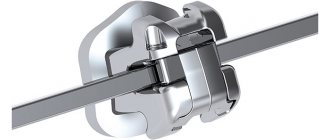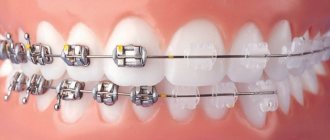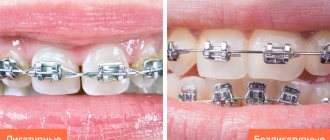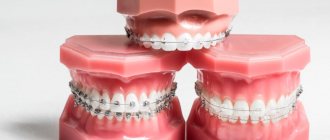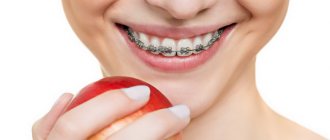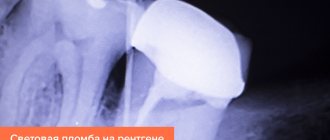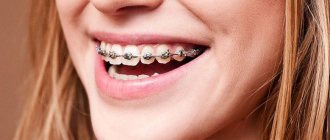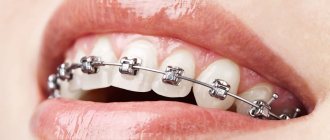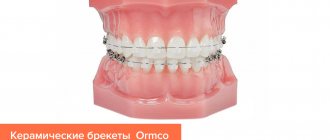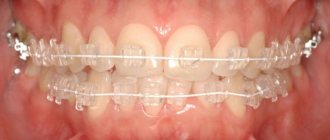Wearing braces helps to effectively cope with dental deficiencies, as well as correct malocclusion. They come in two types: ligature and non-ligature braces. How do these designs differ and which one works better? Let's look at the design features of each type of braces and the selection criteria for installation.
In this article
- Ligature metal systems
- Pros and cons of ligature braces
- Bracket systems without ligatures - what is it?
- Ligature and non-ligature braces: comparison of systems
- What rules must be followed when wearing a ligature braces system?
The orthodontic structure consists of several elements. These are the brackets themselves, which are glued one at a time to each tooth, as well as a metal arch. It passes through the grooves in the braces along the entire dentition, is made of alloys that are safe for the oral cavity and has the ability to return to its original position, no matter how it is bent. This is the principle of operation of bracket systems. The arch initially has the correct shape, which the dentition gradually acquires under its pressure. The movement of teeth occurs in different planes, and this process is regulated by the doctor, accurately calculating the force of the arc - excessive or too little pressure on the teeth can lead to incorrect correction.
It is important for the patient to understand how the system works and strictly adhere to all the specialist’s recommendations so that the effect of treatment meets expectations. Without the control of a competent orthodontist, the results may be zero.
According to the type of fastening, braces are:
- ligatures;
- non-ligated.
Let's take a closer look at each type, find out how they affect the teeth and how to decide on the type of braces to install.
Ligature and non-ligature braces: comparison of designs
Ligature braces got their name due to the presence in the structure of the product of fastening rubber bands or steel wires - ligatures. They are responsible for the tension of the arch and the force of pressure on the teeth. In addition to ligatures, the orthodontic structure contains:
- plates (bases, brackets) – fixed on the teeth and have a small groove for installing an arch;
- arch – made of metal and passes through the grooves of the plates, combining the elements of braces into a single system.
Plates and an arc are also available in non-ligature products. But it is not the ligatures for braces that are responsible for fastening them, but the clasps - fasteners that secure the arches on the plates. An alternative name for non-ligating solutions is self-ligating, since the arch “autonomously” changes the tension force, providing the teeth with the necessary pressure and forcing them to move to the correct place in the jaw row.
The presence or absence of ligatures is the main structural difference between bracket systems. But when choosing parents, this fact is of little interest. There is a more important question: what is better for treating a child’s bite – ligature and non-ligature braces?
Rodikova Tatyana
“When choosing braces – ligature and non-ligature – the doctor first of all evaluates the potential of the design. The impact on the bite, the speed of correction and the patient’s comfort are the main selection criteria.”
Main differences
Self-ligating and ligature braces - what is the difference:
| Ligature | Unligated | |
| Mounting method | Only vestibular (external) | Vestibular, lingual (from the side of the tongue) |
| Materials | Metal, sapphire, ceramics | Metal, sapphire, ceramics |
| Aesthetics | More noticeable | Less noticeable |
| Duration of treatment | From 6 months to 3 years | 20–30% less |
| Frequency of doctor visits | 1 time per month | 1 time every 2 months |
| Adjustment period | Complex, possible pain, rubbing of the mucous membrane | Lighter and faster |
| Comfortable to wear | It is more difficult to adapt - diction may be impaired, salivation may increase | It’s easier to adapt, the period of adaptation is reduced |
| Features of care | Complex, difficult to remove food debris, plaque | Easy care – less food gets stuck, less plaque accumulates, easier to clean |
Self-ligating braces, unlike conventional braces, are installed faster. After gluing the clasps, in the first case, the doctor only needs to insert the arch, but in the second case, he needs to fix it separately on each bracket, which takes a lot of time (up to 3 hours).
Another difference between ligature and self-ligating brace systems is cost. The first one is cheaper, but due to longer treatment and frequent visits to the doctor, the difference in price with the non-ligature one becomes less noticeable.
The risks of complications are higher when using classical options, although in general, according to studies, their probability is 32.7–50%. Basically we are talking about changes in the micro- and macrostructure of tooth enamel (microcracks, chips). (Antonova I. N., Goncharov V. D., Bobrova E. A. Study of the ultrastructural state of hard dental tissues during experimental modeling of orthodontic treatment with fixed appliances. Dentistry. 2017;96(3):5-10.)
Which braces are better: ligature or self-ligating - the patient must decide together with the doctor. The latter are not suitable for solving all clinical cases.
Self-ligating and ligature braces: what is the difference
When ligature-free products first entered the dental market, they were accompanied by aggressive marketing and confident PR from manufacturers. This increased sales, but some exaggeration of the benefits made the professional audience and interested clients skeptical. For a long time there were debates about quality, efficiency and convenience. Research was carried out. The bottom line is that the analysis showed which of the advantages of self-ligating braces are true and which are fiction.
Ligature and non-ligature braces - similarities and differences:
Ligature
The device got its name from the Latin word ligatura, which translates as ligament.
With the help of ligature ligaments, the power arc acting on the teeth is attached to the braces themselves - base plates glued to the teeth with special dental cement.
Orthodontists use two types of ligaments - transparent or multi-colored elastic bands and wires made of steel, aluminum or silver:
- The first ones do not fix the arch strongly enough; they are used in the initial stages of treatment to correct the position of individual crowns.
- The latter are suitable for later stages and the final stage - correcting the bite and ensuring the correct position of the upper teeth relative to the lower ones.
Some patients complain that rubber bands and wires irritate the oral mucosa - the inside of the lips and cheeks. In addition, they need to be changed every month. Sometimes more often, since elastic fasteners tend to stretch and tear.
Rubber bands for braces
Tooth extraction.
The decision to free up additional space for teeth when correcting the bite is made by the dentist. If extraction of healthy teeth is unavoidable, then regardless of the type of braces installed, it will be necessary to visit a surgeon.
Plaksina Margarita
“Teeth preservation is the priority of our dentistry. But in rare cases, removal cannot be avoided. And the type of braces does not matter here. If there is no space for the correct positioning of teeth, it has to be created artificially.”
- Care.
It is easier to clean self-ligating structures, since there are no bulky fasteners that accumulate food debris and complicate the procedure.
- Comfortable to wear.
Plates with ligatures are flatter, but the elastic bands or wire fastenings themselves cause some discomfort. Self-ligating ones are more streamlined, but are about 1 mm thicker. Both options take some getting used to.
- Frequency of visits.
Elastic ligatures stretch and tear - they need to be changed every month. Correction of self-ligating systems is carried out less frequently; the patient comes for an appointment every 1.5-2 months.
Dolotova Marina
“Our orthodontists often invite patients monthly, alternating correction of the upper and lower jaw. This is convenient for the patients themselves – less discomfort, more pleasant treatment.”
- Aesthetics.
The main attention in braces is not the rubber bands and wire, but the base material. He is responsible for the decorativeness and invisibility of braces.
Braces care
Wearing self-ligating braces requires special oral care. For them, it is recommended to purchase a special toothbrush (preferably soft) and a brush. Brushing your teeth is required after every meal. When wearing braces, you should not overeat solid foods. You will also need to give up acidic foods and coloring drinks. Every 2-3 months when wearing braces, you need to visit your dentist.
Braces carefully chosen by an orthodontist will correct any defects in the oral cavity for several years and make your smile perfectly straight and your bite correct.
Materials and types of bracket systems
Corrective dental appliances are made from different materials. The base determines the attractiveness of products and is responsible for strength characteristics and durability. Main braces options:
- Metal.
Noticeable on the teeth, but with many other advantages. Among the advantages of metal are strength, affordability, and elimination of the most serious pathologies. In addition to low attractiveness, the disadvantages include a high degree of injury, but manufacturers are gradually eliminating this defect, making the designs more streamlined and miniature. Doctors install metal non-ligature and ligature braces systems.
- Sapphire.
Less durable, but almost invisible on the teeth. The transparency of artificial sapphire allows the plates to merge with the enamel. The effectiveness of treatment is high. Execution of products - in both versions.
- Ceramic.
When choosing white ceramics, high aesthetics are guaranteed. Strength is lower than sapphires and metal, reliability is also lower. The plates are characterized by increased fragility, which requires the correct selection of menus during the treatment period. Ceramic braces can be non-ligature and ligature braces.
- Plastic.
Suitable for simple correction and elimination of small bite defects. Strength and reliability are low. Dietary requirements – no solids or pigmented foods or drinks. More often used in a ligature version.
The products also differ in the technology of attachment to teeth:
- Vestibular.
The base is attached to the outer (vestibular) surface of the tooth.
- Lingual.
The plates are fixed on the inner (lingual) side of the crown. They are invisible to others - invisible braces.
Lingual ones are made to order, since the base must duplicate the anatomical shape of the teeth.
Disadvantages of systems
Ligature braces have the following disadvantages:
- systems with metal ligatures are contraindicated for people with allergies to metals, oncology, epilepsy, or an implanted pacemaker;
- elastic fastening elements are subject to loss of elasticity, destruction and discoloration, and therefore must be replaced frequently;
- metal fixation parts can injure the tissues of the oral mucosa;
- hygienic care is difficult;
- the need for monthly system setup;
- impossibility of use for periodontal diseases.
Disadvantages of self-ligating systems:
- increased discomfort due to the large volume of the structure;
- relatively high cost.
How to choose braces for a child: self-ligating or ligature
The main criterion for choosing a brace system is the doctor’s recommendations. The orthodontist will look at the young patient’s photographs, make calculations for correction, and conduct 3D modeling. And based on the work done, he will offer options for braces systems. These will be structures that will most quickly and effectively eliminate the current pathology and straighten the bite.
At this stage, children and parents get involved in the choice: evaluate ligature and non-ligature braces based on photos and samples - compare the design, discuss preferences. Some people like colored rubber bands, which the doctor changes every appointment, others want transparent strips to hide the signs of the treatment being performed. It is important to hear the child’s opinion, because wearing braces for a long time - from several months to 2 years.
The optimal option is selected in dialogue, after which the doctor makes an appointment to install a ligature or self-ligating system, and the young patient begins his path to health, beauty and charm.
Indications for installation of self-ligating braces
The main indications for installing self-ligating braces are:
- crowded teeth;
- malocclusion;
- presence of gaps between teeth;
- displacement and incorrect inclination of teeth;
- improper closure of teeth.
Contraindications
Any treatment has contraindications. In the case of installing non-ligature braces, they cannot be installed when:
- caries and its complications;
- gum diseases (periodontitis and periodontal disease);
- poor oral hygiene;
- blood diseases;
- pathology of bone tissue;
- immune system disease.
The process of installing ligature-free braces
The installation of self-ligating bracket systems follows a standard procedure and requires a thorough preparatory process. This process begins with an examination of the oral cavity by a dentist and a full diagnosis. The diagnostic stage consists of taking x-rays and making impressions and impressions of the teeth.
After this, the impressions and photographs are sent to a dental laboratory, where the braces are made. Before installing braces, as well as before starting any orthodontic treatment, professional cleaning of the oral cavity, treatment of caries and inflammatory processes in the gums are carried out. Only after this are bracket systems installed on the dentition.
Attention:
Braces are installed only on perfectly clean and healthy teeth. The presence of tartar and plaque interfere with the quality of surface adhesion.
Unligated
Other names are self-ligating, self-ligating. Their arch is fixed using a micro-lock with a lid, built directly into the braces. Manufacturers of the systems claim that correction of the position of the arc should be carried out no more often than once every two to three months. However, not all doctors share their opinion; some still insist on monthly monitoring.
The advertisement also promises a reduction in treatment time by 20-30% compared to ligature treatments. But according to the results of a number of clinical studies, it took the same amount of time to correct the same pathology in different patients with ligature and self-ligating braces.
Another PR move is painless treatment. Promotional materials say that due to the absence of rubber bands and wires, it is possible to reduce the force pressure on the teeth. There is no friction force between the elastic and metal ligaments and the arch, which means the jaws do not suffer from additional stress.
This belief is true, but only if the arch in ligature braces was fixed by an incompetent doctor who completely or partially neglected the biomechanical features of the device. If the system has been adjusted correctly, there will be no excessive pressure.
Pain is possible when wearing both types of braces. This depends on the individual characteristics of the patients - in particular, on the pain threshold and jaw anomalies themselves.
Self-ligating braces
Vestibular and lingual apparatus
Orthodontists install braces in the oral cavity in two ways: on the vestibular (visible) and lingual (in contact with the tongue) side of the dentition. With the lingual type of fixation, aesthetic indicators are higher, but the period of adaptation to internal braces is more difficult. Patients with lingual devices do not experience psychological discomfort: the devices are almost invisible to others. The cost of invisible structures is higher compared to traditional vestibular systems.
lingual braces STb
Diet restrictions
To prevent braces from breaking or changing the vector of force, you need to reconsider your diet. Orthodontists recommend:
- hard vegetables and fruits must be grated or crushed in a brander before use;
- You cannot bite seeds, chew gum, eat nuts, dried apricots and other dried fruits;
- Avoid consuming very hot or extremely cold foods and drinks;
- limit the intake of food and drinks containing artificial or natural colors (tea, coffee, red wine, soda, berries, etc.).
Important: failure to follow the recommendations given by a specialist may result in system failure. In this case, the device will need to be repaired, which will lead to an increase in the correction period and an increase in the cost of treatment.
Aesthetic system without ligatures - what is it?
It is widely believed that non-ligature braces are a type of aesthetic system. In fact, this is only partly true.
Aesthetic self-ligating braces include ceramic and sapphire designs. Metal ones, although they look more attractive than ligature systems due to small locks, can hardly be called aesthetic. They look neat, but are much more noticeable than designs made of ceramics and artificial sapphires.
Also, aesthetic non-ligature braces include lingual systems - they are attached to the “lingual”, inner surface of the teeth. Such designs are invisible and are often chosen by public people.
The only drawback of non-ligature aesthetic systems is their high price. In order to reduce it, dentists combine materials: in the frontal zone, sapphire or ceramic clasps are fixed on the upper teeth, and metal ones on the lower jaw, chewing teeth.
